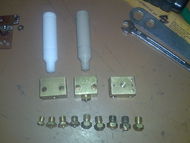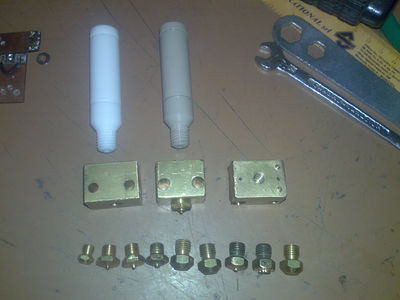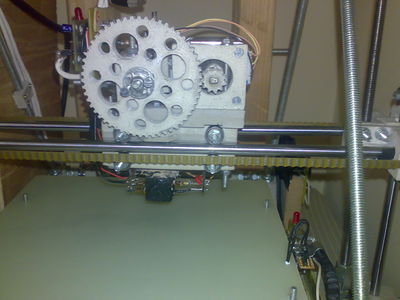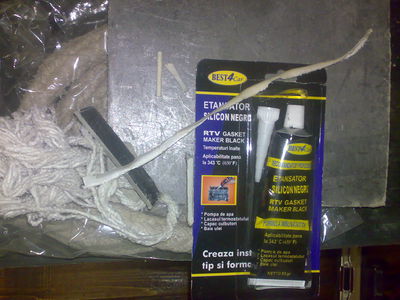DIY Direct hot end
Release status: Experimental
| Description | DIY Alternative direct hot-end
|
| License | |
| Author | |
| Contributors | |
| Based-on | |
| Categories | |
| CAD Models | |
| External Link |
Contents
Disclaimer and Introduction
At this point this is highly experimental, so use at your own risk. Also please edit, post on forum or pm opinions, findings, for the benefit of community - tyvm. Its not sure anything here will be an improvement over current design(s), or if it is any easier to DIY, this is the intention at least, but time should tell.
The older design has a small thread inside a ptfe, where it fits a brass barrel that has a hole alongside and inside it. Originally was using nichrome wire as heating element. I think now most ppls use heater blocks with heater resistors by attaching a heater block on the threaded barrel. There are 2 weak points in the use of this:
- the thread is very small number, thus has small teeths and doesnt grip the thermal barrier very good;
- attaching a heater block on the other end of the barrel makes it to act as a lever, as being subject to all the "giggling" of the reprap movements, inertia, moment forces etc (probably with original nichrome the solution was lighter and this had lower impact)
This variation tries screw the thermal barrier on the heater block, directly, without any middle pieces. Getting rid of the threaded barrel which can cause problems. There are several other designs that more or less, do that, in one way or another, with peek or metal body and ptfe sleeving, etc. This page has nothing original on it, maybe the gas nozzle (havent seen posts with that yet), although i am sure somebody somewhere is already using a gas nozzle just like that, but i just havent found myself any page mentioning that, although i have seen mig welding tips and similar.
Thermal barrier
Here this is assumed to be ptfe. Although some special sorts of peek might work too, especially with the barrel being gone and filament being fed directly into the pool on top of resistors. This has to be proven though. There are several sorts of both ptfe and peek, see here http://forums.reprap.org/read.php?1,79524,80492#msg-80492. There is nothing absolutely generally valid about advanced plastics and usually what matters most is the additive material, which usually is not mentioned. The following are some ideas:
-a ptfe that is ivory-sh color, has a good chance of being the sort that has extra mechanical resistance. Or if its the other similar type (rare), it should fail very soon.
-a peek that is black color, has a chance of being the sort that has improved less friction, also. Remember this is not confirmed to work.
Heater block
Aluminium, brass or inox? Probably aluminium because its lighter. However, its more fragile than the others so its threads might get damaged after repeated abuse. Good thing both threads are on the inside. The thread on the outside of the ptfe in the picture is M10x1.5mm (standard) because that was the tooling and what i considered at the time of making, but M12 (standard x1.75mm) would of had more "meat" between its "teeths".
Nozzle
A minor change is to use another nozzle type. This nozzle is found in any kitchen that has a classic cooking machine with natural gas or a LPG. Its exactly the nozzle from which the gas comes out to be burned. Lift up the top of the cooking machine and you will see it. Typically these nozzles are from 0.3mm up to 0.8mm and with non-standard M6-7-8 thread pitches 1 step lower than the standard, at least that is what i found around, but no doubt the variation can be bigger than this: M6x thread - standard pitch 0.80mm - nozzle gas pitch 0.6 M7x thread - standard pitch 1.25mm - nozzle gas pitch 1.0 M8x thread - standard pitch 1.25mm - nozzle gas pitch 1.0
These nozzles have a blunt ending. Without a lathe, i mounted the nozzle(s) in a chuck of a drill press and using a tool i took few layers around the nozzle output to give it a small clearance to gave the nozzle a ... [1].
The nozzle gets screwed inside the heater block. That means, it can get unscrewed. I have successfully printed with this, and also changed the nozzle directly. It is easier if the heater is at a temperature like 100-150C and if the heater block can be held in place with a wrench and the nozzle can be unscrewed with another wrench. I also did it with filled with hard rock abs inside at room temperature, and the thread torque was enough to break off the abs inside and get the nozzle free. I was having a brass nozzle when doing this, i dont know if aluminium thread would be damaged or not dy doing so.
Mechanical Support (mounting)
The current carriage doesnt really offer many possibilities to fix this on it, so it needs either some improvisation, or carriage needs some redesigning.
Principle Best way to fit this would be to have the heater block in a fixed position and have the thermal barrier free to expand towards the pinch wheel direction. This way the nozzle will always be at the same point.
Support 1 The classic way. This was achieved by pressing the thermal barrier against the top plate of the carriage. Easy enough to do, but thermal expansion makes the nozzle to move towards the bed surface a little.
Support 2 the thermal barrier versions that i made have 2 circular slots for groove type safety locks, one at the top and one at the bottom. I initially thought that the top one should come on top of mendel carriage plate, and prevent the hot end falling down, and the one closer to the nozzle can be used to push against a spring from the bottom of the plate. So that the entire hot end could slide vertically a little. Until it hits the pinch wheel that drives the filament. The spring can give it a little tension. And the overall assembly tends to stay down anyway - at least according to Newton. So there is nothing "against nature" about it. The downside of this approach is that the thermal dilatation will elongate the nose towards the heated bed, in the same direction as before.
Support 3 Two somewhat small u-shaped pieces of metal (or other means - dunno the english name, pls edit to correct this), could be used to tighten the thermal barrier directly, and these can be fixed with 2 nuts onto screws coming from top plate. Not a bad choice, and dilatation will push both ways according which side this assembly is closer to.
Support 4 Having the heater block fixed and thermal barrier 100% free after the thread is also a variant. Heater block can have 2 screws passing through it (above resistors) and these screws being fixed onto the 2 screws already existing, at 90degree angle, with both top and bottom nuts and some plate insulator in between each sides. This way the heater block should be totally fixed (if vertial screws are insulated shouldnt heat up), and the thermal barrier would expand 100% towards the pich wheel, being vertically restrained only by heater block on the down side. At some extent a little constrained by the filament, and horizontal contrained by the hole it passes through.
Probably best would be support points 3 or 4. But remains to be seen.
Alternative miscelaneous materials
Yet other materials, possible replacements of the "typical" ones, to use with reprap for different purposes:
- RTV gasket silicone, its the silicone that can be found virtually at any gas station; it is used as a gasket fill between the engine block and top of the block with the valves. It stands ~350C or so, usually black or red color. I used it to cover the heater block, i dont really have a clue about what temperature exchange is between it and surrounding air, but i guess cant be worse than blank metal exposed. I also used it to cover the underneath of heated bed, so less heat would go towards bottom. Here it can be used to fix the thermocouple or the thermistor on heater block. It dries fairly fast and it its kinda more rigid than the typical sanitary silicone, and gets a fairly good grip on many materials. Its cheap. Probably can be used in several other ways too.
- Huge heating conduct gasket, the types used in steam heating conducts - street lines type. If you seen a big metal pipe that has like 20 big bolts around it, this is the stuff that comes in between. Are gaskets like 20-50 cm diameter, and minimum 4-5 mm thick: usually made by a mix of graphite, azbestos and other insulating materials. Usually have refractory properties up to 500C or 750C. Are fairly hard. Unlike advanced plastics, these are true termal insulators. Cutted in a small strip, i used this as retainer on the thermal barrier. Sort of instead of peek. This material is also available in plate shape, prior to be cutted round to fit the pipes.
- High temperature vowen tubing, covered with silicone, the type that is generally used in electronics to cover wires exposed to heat. The silicone type is somewhat elastic. Tubing that can be cutted in length, and basically used as a bandage to cover the heater block or to insulate other things, with silicone on it. Strange enough, the silicone on top of it once ignited, burns very well, and when its done burning the woven material inside remains clear and can be used at much higher temperatures. I used the woven material to "dress up" the first resistors i had on the heater block, but after that i got bored and covered them in kapton as i started to believe that kapton had better heat transfer.
Considerations
Advantages
- thread on the outer perimeter of the thermal barrier can be made much bigger (M10-12-14) thus being much more robust than the variations that use a thread inside the ptfe;
- no barrel: one less thing to clean or to care for;
- interchangeable nozzle(s);
Disadvantages
- a heater block made from brass is fairly heavy, and with all the "giggling" of a reprap, it might put additional pressure on the thermal barrier and its thread; this remains to be seen;
Effects to be determined
- if dilatation of the thermal barrier is bigger than the material used as heater, it will strengthen the joint, otherwise the opposite might be valid
- thermal barrier going inside the heater block: the melt zone changes accordingly;
- remains to be determined if M10x1.5mm thread on the outside of ptfe is strong enough, or other thread types should be considered;



